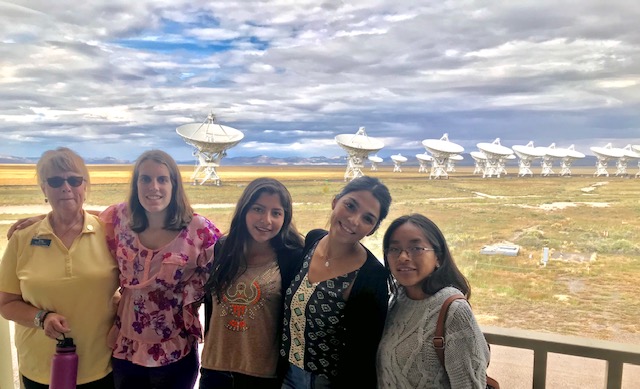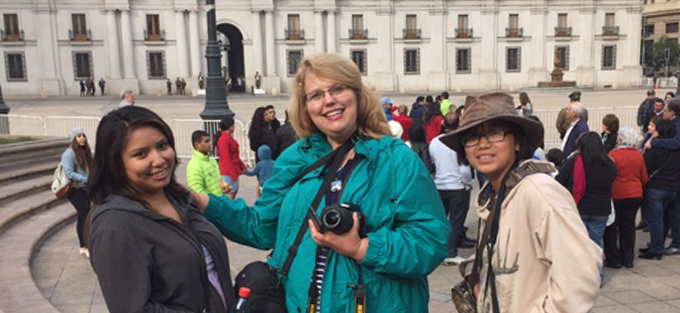Young People From San Pedro De Atacama and New Mexico Share Indigenous Vision of the Cosmos
10 January, 2019 / Read time: 5 minutes
To learn firsthand about school life for their peers in New Mexico, participate in astronomy-related activities, visit the Karl G. Jansky Very Large Array (VLA) and share their communities’ respective understanding of the cosmos, a teacher and students from the school Liceo Agropecuario Likan Antai in San Pedro de Atacama traveled to Socorro, New Mexico, as part of the Observatories and Sister Cities program, led by the US National Radio Astronomy Observatory (NRAO) and Associated Universities Inc (AUI).
Eleventh-grade students from the school Liceo Agropecuario Likan Antai in San Pedro de Atacama, which is adjacent to the ALMA Observatory, visited the Karl G. Jansky VLA facilities, accompanied by their teacher, and also visited their peers in a New Mexico school. In addition to the astronomy-related activities, the participating students are working on a project that focuses on the ethno-astronomic heritage and vision of the cosmos that identifies the Atacameño and Navajo communities.
The Observatories and Sister Cities program began in 2006 to promote cultural exchange between high school teachers and students, strengthen teaching practices and reinforce learnings in the areas of science, technology, engineering and mathematics (STEM).
The Chilean delegation, now back in Chile, included the participation of 2 students and their teacher from the school Liceo Agropecuario Likan Antai, specifically students Iara Ortega and Carolain Bautista, and Catalina Atenas, professor of differential and integrative education with the Educational Integration Program. In New Mexico, the young people had the opportunity to meet with NRAO staff, participate in observatory research at New Mexico Tech and visit the “Alamos” Navajo indigenous reservation. They also enjoyed a hot air balloon festival in Albuquerque and toured Socorro and the Magdalena Box Car Museum.
Chilean student Iara Ortega, a high school junior in the humanist-scientist program, said: “My project involves combining science and art, because I believe that art expresses and science explains. I believe that both subjects go hand in hand and together can generate new ideas that people can learn from. My project uses paintings, pictures and photos to present astronomical phenomena and explain milestones like the Big Bang, the explosion of a star and the generation of a nebula.”
In New Mexico, according to the student, they learned about really interesting teaching methods like the use of light murals, a type of graffiti that expresses the Navajo understanding of the cosmos, explaining science from the perspective of cultural heritage. This experience was amazing. Personally, what I found most interesting was that the Navajo people use natural crystals and stones to look at the sky and for thousands of years they have performed healing rituals with stones like amethyst and others to cure people from physical and emotional pain. A powerful tradition that they have passed on to new generations.”
Carolain Bautista, a high school junior in the tourism program, shared: “My project is basically on the Atacameño understanding of the cosmos. Once we were chosen for the exchange, we had to unify out projects, which we named Atacameño Ethno-astronomy. In New Mexico, I was able to enrich my research through the exchange of information on ethno-astronomy, and we are going to do a brief comparison between both cultures, which will include testimonies from Atacameño descendants in our region. In the United States, we toured the Navajo community of Los Alamos, and they shared really interesting information about learning from the senses and contact with the natural environment.
This is a tremendous opportunity for cultural exchange, and students apply with a specific research project, explains Catalina Atenas, Chilean professor responsible for the delegation. “This year we were able to combine scientific and artistic projects centered on the Atacameño vision of the cosmos. For me as a teacher, this was a beautiful experience where we learned about different spaces for astronomic research, new teaching methodologies and amazing places.” In the past, she comments, this program was focused only on cultural exchange, but now it has taken on a deeper perspective through the application of research projects. “Just as our experience exceeded our expectations, I hope that the same holds true for the New Mexico delegation when they come in March, just in time for International Astronomy Day,” adds the professor.
Atenas assures: "Talking about it is not the same as experiencing it firsthand. No method of learning is as effective as learning by doing. We had the opportunity to discover other learning methodologies. Even though our school offers the subject Cultural Identity and also holds astronomy workshops and tours of ALMA, which facilitated this exchange, we discovered many similarities between the two academic communities and indigenous identity, which would not have been possible simply through words.”
The Liceo Agropecuario Likan Antai was founded in 1994 and currently has 474 students, about 80 of which are enrolled through the integration program. Student come from neighboring communities and are enrolled in 7th through 12th grade. An important part of the student body has close ties to the Atacameño culture and this relationship is cultivated across all educational, recreational and environmental activities.
The school offers educational programs in Administration, Agriculture, Tourism and Electricity. Since 2010, it has also offered the Humanist-Scientist program, and since 2016, it has incorporated a special integration classroom, known as “Laboral 1” for students with Special Educational Needs. Likewise, Likan Antai implements a Bilingual Exchange Education Program through all sub-sectors with a traditional educator in the Atacameño language (Kunza) and carries out different projects to promote learnings, such as: “Atacama Fertile Soil” and “Academic Cooperative,” promoting inclusion in a broader sense, with the participation of students, teachers, administrative staff and civil society.
Additional Information
ALMA is a partnership between ESO (on behalf of its European Member States), NSF (USA), and NINS (Japan); together with NRC (Canada), MOST and ASIAA (Taiwan), and KASI (Republic of Korea), in cooperation with the Republic of Chile. The Joint ALMA Observatory is operated by ESO, AUI/NRAO, and NAOJ.

